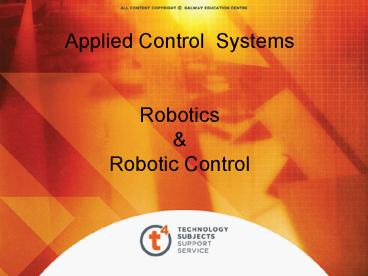Applied Control Systems Robotics - PowerPoint PPT Presentation
Title:
Applied Control Systems Robotics
Description:
Applied Control Systems Robotics & Robotic Control DC Motors Most common and cheapest Powered with two wires from source Draws large amounts of current Cannot be ... – PowerPoint PPT presentation
Number of Views:80
Avg rating:3.0/5.0
Title: Applied Control Systems Robotics
1
Applied Control SystemsRoboticsRobotic
Control
2
DC Motors
- Most common and cheapest
- Powered with two wires from source
- Draws large amounts of current
- Cannot be wired straight from a PIC
- Does not offer accuracy or speed control
3
Stepper Motors
- Stepper has many electromagnets
- Stepper controlled by sequential turning on and
off of - magnets
- Each pulse moves another step, providing a step
angle - Example shows a step angle of 90
- Poor control with a large angle
- Better step angle achieved with the toothed disc
4
Stepper motor operation
Step1
5
Stepper motor operation
Step 2
6
Stepper motor operation
Step 3
7
Stepper motor operation
Step 4
8
Stepper Motors
- 3.6 degree step angle gt 100 steps per
revolution - 25 teeth, 4 step 1 tooth gt 100 steps for
25teeth - Controlled using output Blocks on a PIC
- Correct sequence essential
- Reverse sequence - reverse motor
9
Servo motors
- Servo offers smoothest control
- Rotate to a specific point
- Offer good torque and control
- Ideal for powering robot arms etc.
- However
- Degree of revolution is limited
- Not suitable for applications which require
- continuous rotation
10
Servo motors
- Contain motor, gearbox, driver controller and
potentiometer - Three wires - 0v, 5v and PIC signal
- Potentiometer connected to gearbox - monitors
movement - Provides feedback
- If position is distorted - automatic correction
5V
11
Servo motors Operation
- Pulse Width Modulation (0.75ms to 2.25ms)
- Pulse Width takes servo from 0 to 150 rotation
- Continuous stream every 20ms
- On programming block, pulse width and output pin
- must be set.
- Pulse width can also be expressed as a variable
12
Open and Closed Loop Control
- All control systems contain three elements
- (i) The control
- (ii) Current Amplifiers
- (iii) Servo Motors
- The control is the Brain - reads instruction
- Current amplifier receives orders from brain and
sends - required signal to the motor
- Signal sent depends on the whether Open or
Closed loop - control is used.
13
Open Loop Control
- For Open Loop Control
- The controller is told where the output device
needs to be - Once the controller sends the signal to motor it
does not - receive feedback to known if it has reached
desired position - Open loop much cheaper than closed loop but less
accurate
14
Open Loop Control
15
Closed Loop Control
- Provided feedback to the control unit telling it
the actual - position of the motor.
- This actual position is found using an encoder.
- The actual position is compared to the desired.
- Position is changed if necessary
16
The Encoder
- Encoders give the control unit information as to
the actual - position of the motor.
- Light shines through a slotted disc, the light
sensor counts - the speed and number of breaks in the light.
- Allows for the calculation of speed, direction
and distance - travelled.
17
Closed Loop Control
- The desired value is compared to the actual
value. - Comparator subtracts actual from desired.
- The difference is the error which is fed to the
controller - which generates a control action to eliminate
the error.































